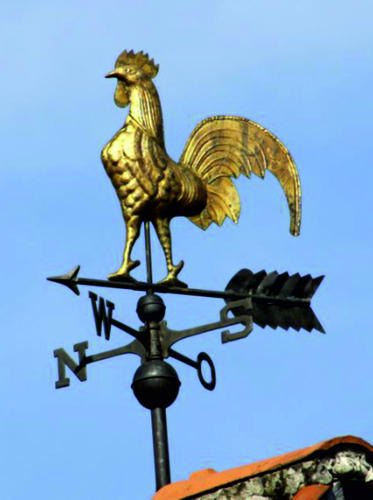Introduction-The blowing air is called as wind. Storms are the very high speed winds. When thunder and lightning occurs with storms, it is called as thunderstorm. Cyclone is a very high speed wind revolving around a low air pressure system. The central low air pressure system is called as ‘eye of cyclone’.
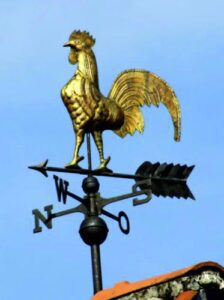
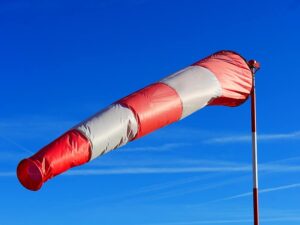
Characteristics of Air-
1. AIR EXERTS PRESSURE
2. HIGH SPEED WIND IS ACCOMPANIED BY REDUCED AIR PRESSURE.
3. AIR EXPANDS ON HEATING
1. AIR EXERTS PRESSURE- A tin can was filled with some amount of water and lid is closed. It was heated so the water inside it changed into water vapour. When the cold water is poured over on it, the hot tin can gets shrink. It is due to changing of water vapour into liquid water and applying of air pressure from outside.
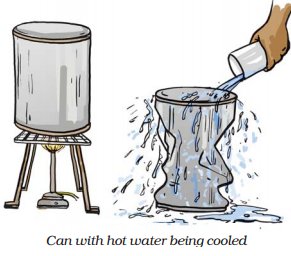
2. HIGH SPEED WIND IS ACCOMPANIED BY REDUCED AIR PRESSURE-
Example 1-
Due to blowing of air from mouth in between the flattened balloons, the air pressure gets reduced in between them. So, the air pressure on other side brings the two balloons close.
Example 2-
In an empty bottle, a small piece of crumpled paper was kept. When the air is tried to blown inside the balloon, the piece of paper falls outside. It is because of reduced air pressure just outside the mouth of the bottle.
Example 3 –
A strip of paper about 20 cm long and 3 cm wide was taken. It was holded by thumb finger and forefinger near the mouth.
When air is blown with fast speed from mouth, the paper strip lifts up and blows. It is because of reduced air pressure above the paper strip. So, the air puts pressure from below and side to lift it up.
From these examples it is clear that air blows from the region of high air pressure to the region of low air pressure.
3. AIR EXPANDS ON HEATING-
The air being warm becomes lighter than cold air. So, the balance of air in both the paper cups becomes imbalanced.
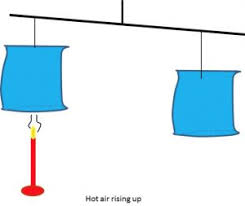
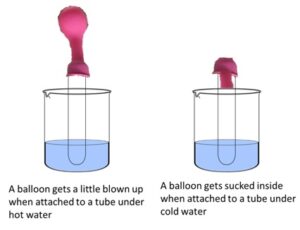
Wind-
The blowing air is called as wind. The air blows from region of higher air pressure to region of lower air pressure.
It is due to –
(a) Uneven heating between the equator and the poles by sunlight.
(b) Uneven heating of land and water
(a) Uneven heating between the equator and the poles by sunlight-
The area close to the equator receives maximum heat while are near poles receives least heat of the sunlight.
The earth can be divided into-
| S.N. | Northern Hemisphere | S.N. | Southern Hemisphere |
|
1. |
0- 30 Degree North |
1. |
0- 30 Degree South |
|
2. |
30-60 Degree North |
2. |
30-60 Degree South |
|
3. |
60-90 Degree North |
3. |
60-90 Degree South |
The heating in between the latitude belts is different from each other. So, the circulation of air currents is set up between the latitude belts. The rotation of the earth causes the change in the direction of wind.
Wind pattern and Coriolis effect-
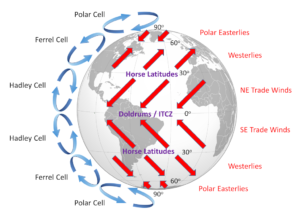
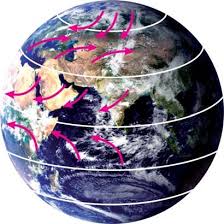
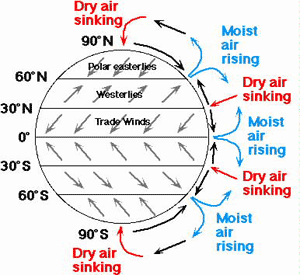
(b) Uneven heating of land and water-
In summer, the land near the equator becomes much faster than the ocean. Also, during day the land becomes comparatively warmer than ocean. The hot air rises up and to fulfill this lackness air moves from ocean towards land. These are monsoon winds.
{Note- The word ‘monsoon’ is derived from the Arabic word ‘mausam’, which means ‘season’.
Southwest Monsoon
Sea (High Air Pressure) à Land(Low Air Pressure)
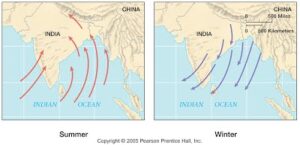
Northwest Monsoon
Land (High Air Pressure) à Sea (Low Air Pressure)
DIFFERENCES-
| S.N. S.N. | Southwest Monsoon SOUTHWEST MONSOON | Northwest Monsoon NORTHWEST MONSOON |
|
1 |
It moves from ocean to land. |
They move from land to ocean. |
|
2 |
It is formed in summer season. |
It is formed in winter season. |
|
3 |
Indian Ocean is at higher air Pressure. |
Indian Peninsula is at higher air Pressure. |
|
4 |
Cause lots of Rain. |
Causes comparatively less rain |
Thunderstorms- The thunderstorms develop in hot, humid tropical areas like India very frequently. The rising temperature produce strong upward rising winds carrying water droplets (moisture),where they become freeze and fall down. The collision between rising air current and falling water droplets produce lightning and sound called thunderstorm.
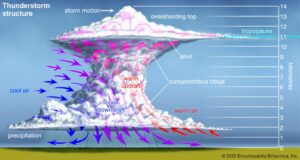
Precautions during a thunderstorm-
- Do not take shelter under a large tree. Choose a small tree. Do not lie on the ground.
- Do not take an umbrella with metallic holder.
- Do not sit under metal shed, open garage, storage shed as the attract lightening. Do not sit near open windows.
- A car, bus is comparatively safe to take shelter because of rubber tyers (insulator of current).
- Never be in water and near water bodies.
How a thunderstorm changes into a cyclone-
| 1. Difference in temperature between two areas |
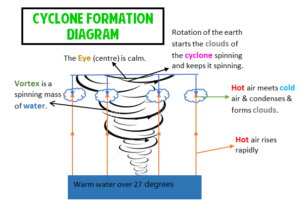
Cyclone is a low air-pressure with very high speed winds revolving around it. Cyclones are very powerful storms. The central low air-pressure area is called as its ‘eye of cyclone’.
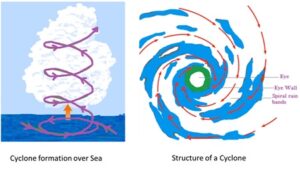
The eye of cyclone may be 8 -200 K.m. wide. The speed of cyclone wind can be 150 – 250 K.m./h. The central vortex height may be upto 150 K.m. in height. The eye wall of cyclone shows maximum wind speed and heaviest rainfall.
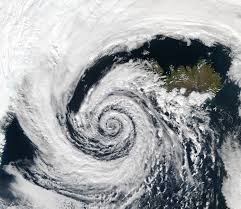
Different Names of cyclones-
1. Hurricane- American Continent- North Atlantic and Pacific Ocean
2. Typhoon- Philippines and Japan- North Pacific Ocean
3. Cyclone- Indian Ocean, Bay of Bengal, Arabian Sea
TORNADOES-
A tornado is a dark funnel shaped violent rotating column of air that reaches from sky to the earth. They are destructive fast rotating winds. Their narrow end touches the earth and wide end remains in the sky.A Tornado may form within a cyclone. The most violent tornado may attain a speed of about 300 km/h. The diameter of tornadoes may be from 1 m to about 1 km. The base of tornado has a low pressure area that sucks dust, debris and anything in its range and throws them out near the top.
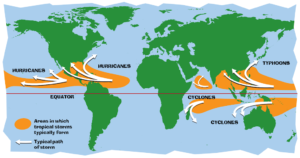
In India, tornadoes are not very common. In American continents they are often seen. The best way to protect from tornado to close the windows and doors and take shelter under the strong table. Bow down on knees protecting the head and neck with your hands. Tornado shelter rooms are also prepared inside the basement/underground without any window. Tornado is also called as twister.
Disaster Preparedness-
Disaster preparedness involves preparations for disasters. It includes emergency evacuation, mass decontamination, vaccination, quarantine etc. Indian metrological department with the help of satellites and radar can issue cyclone alerts and cyclone watch –messages before 48 hours and cyclone warning before 24 hours for the people to prepare for the incoming disaster. In coastal areas, listening of cyclone forecasts, warning systems etc. are essential to reduce the damage. Following are the precautions-
1. The warnings issued on radio, T.V. and newspaper must not be ignored.
2. Try to shift to a safe place with essential goods, vehicles, cattles, pets etc.
3. Phone numbers of local police station, hospital, fire brigade etc.
4. Do not go in waterlogged areas especially with vehicles.
5. Potable water, essential goods, medicines should be stored.
6. The electric wires and switches should not be touched especially with wet hands.
7. A rescue team can be formed with the help of friends and neighbours to help each other.
After cyclone, the safe returning to the home, seeking the help of government agencies, N.G.Os, (Non Government Organizations) hospital, police can be taken.
EXERCISE QUESTIONS (SOLVED)
Q.1 Fill the missing words in the blank spaces in the following statements:
(a) Wind is ………….air.
(b) Winds are generated due to ……………….. heating on the earth.
(c) Near the earth’s surface ………………… air rises up whereas …………….. air comes down.
(d) Air moves from a region of ………………… pressure to regions of ……………. pressure.
Ans- (a) moving (b) uneven (c) warm, colder (d) high, low
Q.2 Suggest two methods to find out wind direction at a given place.
Ans-The two common methods to find out direction of wind are-
(i) The wind sock or pointer of a wind vane can be used to find direction of wind.
(ii) The unfurled flag can give direction of the wind.
Q.3 State two experiences that made you think that air exerts pressure (other than those given in the text).
Ans- (i) Riding a bicycle becomes easy when someone is cycling in the direction of wind. It is because air puts pressure on the rider.
(ii) The cloths hanging on the rope for drying starts fluttering in strong wind because of air pressure.
Q.4 You want buy a house. Would you like to buy a house having windows but no ventilators? Explain your answer.
Ans- I would like to buy a house having windows and ventilators both. The windows and doors allow the normal air to come inside the house. The warm air of house and smoke of kitchen being lighter will rise up and come out though ventilators. This will help in circulation of air. In absence of ventilators there will be suffocation and discomfort inside the house.
Q.5 Explain why holes are made in hanging banners and hoardings.
Ans-Air puts pressure in all directions. The holes made in hanging banners and hoardings allow the air to pass through them. Thus, the holes prevent their damage in strong wind.
Q.6 How will you help your neighbours in case cyclone approaches your village /town.
Ans- In case cyclone approaches my village or town; I will help my neighbours as following-
-I will help my neighbours by communicating with government agencies like NDRF, police, fire brigade, hospitals, medical centers etc. when needed.
– I will help my neighbours in shifting their household goods, domestic animals and vehicles to safer place.
Q.7 What planning is required in advance to deal with the situation created by a cyclone?
Ans-The following plannings are required to deal with the situation created by a cyclone-
1. The warnings issued on radio, T.V. and newspaper must not be ignored.
2. Try to shift to a safe place with essential goods, vehicles, cattles, pets etc.
3. Phone numbers of local police station, hospital, fire brigade etc.
4. Do not go in waterlogged areas especially with vehicles.
5. Potable water, essential goods, medicines should be stored.
6. The electric wires and switches should not be touched especially with wet hands.
7. A rescue team can be formed with the help of friends and neighbours to help each other.
After cyclone, the safe returning to the home, seeking the help of government agencies, N.G.Os, (Non Government Organizations) hospital, police can be taken.
Q.8 Which one of the following place is unlikely to be affected by a cyclone.
(i) Chennai (ii) Mangaluru (Mangalore) (iii) Amritsar (iv)Puri
Ans- (iii) Amritsar
Q.9 Which of the statements given below is correct?
(i) In winter the winds flow from the land to the ocean.
(ii) In summer the winds flow from the land towards the ocean.
(iii) A cyclone is formed by a very high-pressure system with very high-speed winds revolving around it.
(iv)The coastline of India is not vulnerable to cyclones.
Ans-(i) In winter the winds flow from the land to the ocean.
§ THANKS §
